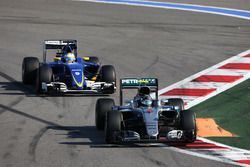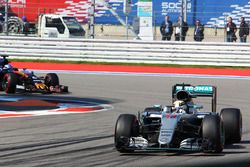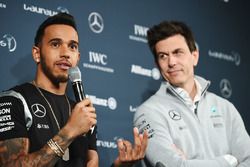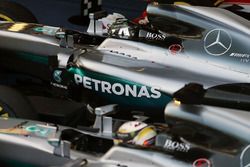Analysis: Why Mercedes had an "absolute nightmare" on its hands in Sochi
On the surface, the Russian Grand Prix appeared to be another routine 1-2 finish for Mercedes, but the Silver Arrows had their hands full getting both cars to the finish, as Adam Cooper reveals.

Photo by: XPB Images



































In terms of excitement, the Russian GP was always going to be compromised by the traditional Sochi one-stop strategy, and we were never going to see the sort of strategic variation provided by the three tyre compounds in the earlier races of 2016.
Then, just to spoil things further, problems for Sebastian Vettel and Lewis Hamilton left them out of position on the grid, and thus once again unable to take on poleman Nico Rosberg in a straight fight.
Heading into the race, the main interest was therefore focussed on how well they could recover - Hamilton in particular. This time, fortune went his way on the opening lap, and it didn't take the World Champion too long to get up to second.
However, Rosberg remained in control up front, and that would be as far as Lewis would get.
But this was far from a routine afternoon for the Mercedes team, and in the end Hamilton was fortunate to bring home those precious 18 points.
“Both cars had issues with their engines through the race,” Paddy Lowe told Motorsport.com. “To you it probably looked like a dead easy race, a bit of a cruise.
"But from the pit wall it was an absolute nightmare. It sounds terrible to say that, but particularly on Lewis's side there was no water pressure in the engine from 20 laps to go, so there's no way that car should have finished...”
Flying in new parts
Hamilton's 2016 bad luck had first struck with another power unit issue at the end of Q2, after he had already guaranteed himself a safe passage through to Q3.
Unable to take part in the final session he was thus classified 10th, which was not as disastrous as when he faced the same problem in China. However, he was not yet out of the woods, as Mercedes had to ensure that he could still start from that position, and not from the pitlane.
The complication was that for this race Mercedes had upgraded its fuel system, and, to its credit, had supplied all six customer cars, as well as its own. That was a big commitment, and there were no spare parts on hand.
When the qualifying problem forced Hamilton to re-use his older engine – now passed fit and ready to be pressed back into service – it had to be equipped with the new fuel system.
If it wasn't, this would be a change of car specification, and a pitlane start. There simply wasn't enough time to swap the system over from the engine Lewis used in qualifying without pulling the car out of parc ferme, which again would ensure a pitlane start.
Fortunately, a ninth set of parts had just become available in Brixworth. If the team could get their hands on the new kit, they could work all night to prepare the spare engine – which was not subject to parc ferme rules.
So a chartered jet was pressed into service, and a few strings pulled by a helpful Bernie Ecclestone.
“It was a bit of a logistical nightmare to be honest,” said Lowe. “As you know, we upgraded the engines for this event, but as is often the case when you have to do eight engines we didn't have some spares of some fairly minor parts on the fuel system.
“But in order to preserve parc ferme we had to fly in bits overnight. They were ready, they were from a later batch that we were bringing along for Spain. The engine that we were putting back was not in parc ferme, so we were able to work on that during the night, and then put it in the car in the morning.
“Ironically we had the bits on the other engine that we could have swapped over, but you're not allowed to do that during the night. The only reason we had to use the plane was the nuances of the parc ferme regulations.”
The plane made it to Sochi at 1.50am. This was a big job, but the mechanics were able to work in shifts. “There were various phases to the process, it wasn't the same people all the way through, so I think everybody got the sleep they needed, pretty much...
“It's great when a plan like that comes together. If the plane didn't make it, what were we going to do? I think at that point we would have been forced to break parc ferme, and start from the pitlane.”
Avoiding first-corner chaos
And so, after all that effort, and with the engine fired up and passed fit, Hamilton was able to take his 10th spot on the grid.
He had joked on Saturday that he just wanted to get around the first lap safely after collisions in the last two races, and when the Daniil Kvyat/Sebastian Vettel confrontation began to unfold, he could be forgiven for thinking: 'not again!'
This time, though, he avoided the trouble, and in fact he was one of the biggest beneficiaries of the Turn 2 confusion.
“I didn't have a good start performance-wise,” said Hamilton. “I put myself on the outside because I could see everyone was on the inside, and as I was braking down I was just turning in, and as I was turning in out of the corner of my eye I saw some commotion.
"I was like, 'stuff that,' so I turned left...”
He duly skated across the run-off area at barely abated speed – indeed it looked for all the world like he actually accelerated – and by ducking neatly to the left of the FIA's marker bollard, he didn't get a penalty.
He got back on track and, after the second act of the Vettel/Kvyat drama unfolded, he was in fifth place when the Virtual Safety Car came out.
This was a better outcome than anyone at Mercedes could have hoped for, and with Daniel Ricciardo, Sergio Perez, Vettel, Kvyat and Max Verstappen all taken care of, he had already made his life a lot easier, and given himself a much better chance of working his way onto the podium.
Scything through the traffic
When the VSC was withdrawn at the end of Lap 3, Hamilton wasted no time in dealing with Felipe Massa, putting himself into fourth behind only Rosberg, Valtteri Bottas and Kimi Raikkonen, the last two having also swapped positions just after the resumption.
It took Lewis just four laps to deal with Raikkonen, and that put him on the tail of Bottas.
The Williams man had some good speed, and was much more of a challenge. The single stops were always going to be crucial, and Lewis trailed his rival for seven laps before Bottas pitted on Lap 16.
Hamilton came in the lap after that, but it was not a perfect stop, and he lost some precious tenths. This time he bore some responsibility.
“He went a bit long and a bit to the right,” said Toto Wolff. “And in going out he apologised. The car has to be choreographed in a very precise way, the car needs to be precisely on the spot, and in the heat of the moment that isn't always possible.”
The lost time could have proved crucial, for while Lewis emerged just in front of Bottas, the Finn had the momentum and the racing line, and he swept back past.
It was logical to assume that Lewis would find himself stuck again, but within two laps he had found a way by as the two of them arrived on the tail of Fernando Alonso, who had yet to stop.
A lap after that, Kimi pitted, and having stayed out four laps longer than Bottas, he was able to jump his fellow countryman. That was also the trigger for leader Rosberg to come in on Lap 21.
When it all sorted itself out, Nico was 12.9s ahead of Lewis with 30 laps to go – and everyone was on soft tyres with which they planned to go to the end.
Drama on Rosberg's car
That wasn't really much of a recipe for excitement, so now it was a question of watching that gap between the Mercs and seeing if either of the drivers hit any problems. And not long after the stops, something did materialise for Rosberg.
“As a matter of fact, we had a problem on Nico's car, which gave us some grey hairs during the race, a problem on the MGU-K drive,” said Wolff.
“It looked at a certain stage that he wouldn't finish the race. We are pushing the limits on the chassis and engine side a lot in order to have a competitive car, and this is why we are winning races. But also if you push the limits at a certain stage you find them.”
Lowe added: “Nico had a problem with the MGU-K, so we were trying to manage that. The problem wouldn't have affected him to his knowledge, we were just telling him to take it easy. It wasn't a problem that would immediately hurt the performance or be noticeable to him at all.”
Within the Merc camp, opinions varied as to how serious it was. After the post-race debrief, Nico himself admitted he was “very close to not making it to the end as well,” while Hamilton was keen to stress he had been told by the engineers that Nico's problem was not potentially terminal.
It's hard to judge how much time he lost as a direct result of adapting, because it coincided with him hitting traffic.
The gap had been pegged at around 12s for a while, but from Lap 31 on it went: 11.1s, 9.6s, 8.4s, 8.3s, 7.7s, 7.5s.
From the outside at least, it appeared that Hamilton might actually be in with a shout. Indeed he noted afterwards: “There wasn’t a doubt in my mind that I could win it.”
Water pressure woes
In fact, that 7.5s was as close as Hamilton would get. It was at exactly this point that we heard his engineer tell him, “It looks like we have a water pressure issue,” and thereafter it was a fight to get to the finish, rather than a fight with his teammate.
“We were telling him the situation,” said Lowe. “And backing off obviously gives you a little bit more temperature margin, which would be a moderate help. Backing off is helpful, but it shouldn't have been an answer, it should never have finished.”
After a few laps, Lewis was told that “the situation has stabilised,” although that wasn't as positive as it might have sounded.
“Well, it stabilised at zero!” quipped Lowe. “Basically it was a true statement...”
Rosberg was unaware that Lewis had a problem, but he insisted that he had things under control anyway.
“I knew his lap times and it was just down to the traffic,” he said. “It was a long stint on soft tyres so I had that opportunity to use that gap to use the tyres a bit less initially, and to have more at the end of the race. And it definitely worked that way and I had plenty of tyre left, so I could push comfortably.”
Was his pace compromised by the MGU-K issue?
“For sure, I lost a fair chunk of performance definitely because I turned everything down, but I had a healthy gap. I wasn't aware he had to turn things down, I thought it was tyres, he definitely used them more than me in the second stint.”
Pushing to the finish
Notwithstanding any worries about his car, Rosberg made good use of those tyres as he banged in a new lap record on the penultimate lap, and he kept pushing even on his final lap.
Hamilton, in contrast, backed off dramatically, allowing the gap to drift out to 25s by the flag. He was just happy to see it, while mindful of the fact that his engine might not have much future life left in it.
“For sure today when I've got myself up to second, I've got it down from 12-13s to 7s, still with nearly 20 laps to go, I'm on it, and then I'm told I've got an engine problem, and my thought is 'I'm not going to finish the race', so I'm just grateful that I did.
"I'll do whatever I can with whatever else I have left from these damaged parts to keep fighting...”
Mercedes really was in a class of its own in Russia, more so than in previous races, and Rosberg was keen to point out that the car felt better than ever.
Will that trend be continued? Toto Wolff remains cautious: “The track is very different, a very smooth surface, and you can see the pace from many teams was different to the races before.
“Williams was very strong here, Red Bull not strong at all, Ferrari not as good as expected. This is a particular circuit where you have to get it right in terms of mechanical grip and aerodynamic downforce, engine power plays a role.
"So I would say the blip in performance that we have seen from Ferrari is Sochi-specific, but again, I didn't see their data, so I don't know.”
Be part of Motorsport community
Join the conversationShare Or Save This Story
Subscribe and access Motorsport.com with your ad-blocker.
From Formula 1 to MotoGP we report straight from the paddock because we love our sport, just like you. In order to keep delivering our expert journalism, our website uses advertising. Still, we want to give you the opportunity to enjoy an ad-free and tracker-free website and to continue using your adblocker.























Top Comments